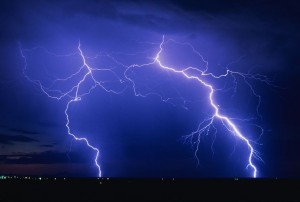 Although lighting strike deaths have gone down in the last few years, lightning is still one of the most deadly weather events. Those who survive can suffer serious injuries. Neurological injuries are the most common, after being struck by lightning. Survivors may suffer damage to the ears and eyes including ruptured eardrums and later development of cataracts. Lightning strikes can result in cardiopulmonary complications. There is no way to be safe from lightning if you are outside during a thunderstorm, so if you hear thunder get inside right away.
Although lighting strike deaths have gone down in the last few years, lightning is still one of the most deadly weather events. Those who survive can suffer serious injuries. Neurological injuries are the most common, after being struck by lightning. Survivors may suffer damage to the ears and eyes including ruptured eardrums and later development of cataracts. Lightning strikes can result in cardiopulmonary complications. There is no way to be safe from lightning if you are outside during a thunderstorm, so if you hear thunder get inside right away.
Get Inside
If you can hear the thunder, lightning is close enough to strike you. The National Weather Service (NWS) used to recommend crouching to minimize your risk of being struck if you are trapped outside, but stopped recommending the crouch in 2008, because it seemed to be giving people the impression that crouching offers more protection than it really does.
If you absolutely cannot get inside of a building that has electricity or plumbing or inside a vehicle that has a metal roof, there are some things you can do to reduce your risk of being struck:
- Stay away from objects that conduct electricity, such as power lines, metal fencing, and windmills.
- Get out of the water.
- Stay away from isolated trees.
- Do not lie flat on the ground.
- Get off of elevated areas such as hills and peaks.
Staying Safe Inside
The only way to be safe is to stay indoors, and even when you are inside, there are still some risks:
- Do not talk on corded phones.
- Stay away from equipment that can put you in contact with electricity, such as your television.
- Do not use a computer that is plugged in to electricity or a wired internet connection. Use a laptop, tablet or similar device that is not plugged in instead.
- Stay away from sinks, showers, and other plumbing.
- Stay away from windows and doors.
- Avoid contact with concrete floors and concrete walls.















